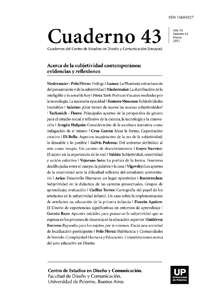Habitancia y Comunidades de Sentido. Complejidad Humana y Educación. Consideraciones acerca del acto educativo en Diseño
Abstract
What is taught, and what is learned ? Education with its various aspects as systematic reflection, a compendium of training methods for a particular context, in itself has become a stream of potential pragmatic, efficient and conclusive, that have framed the subject in a container of knowledge, as operative entities from the reactions driven by an impulse or case study, and not in a system that tends to complementarity, unity and overall benefit from the sensitive and vital perspective. In this wide spectrum of possibilities, the validity of teaching and learning leads in to recognize as a fundamental premise for a subject, a man or woman in a society that has faced since the classroom to have more than knowledge and the central axis of their work, their role, and has been structured from the essence of education and the human condition. This paper raises from the perspective of designing a reflection on the elements of structure and power, which are given from classroom design and from the roles of both Teacher and Student, where the creative emergency search not only the differentiation of tangible-product-design process, but the recognition of subjects whom through the educational help others to be.
References
Bauman, Z. (2001). La Sociedad Individualizada. Madrid: Ediciones Catedra.
Cassirer, E. (1984). Antropología Filosofica. México: Fondo de Cultura Económica.
Dinham, S. (1991). La enseñanza del Diseño: El diseño de la enseñanza. En J. Pericot, Pedagogia del Diseño (págs. 138-149). Barcelona: Gustavo Gilli.
Dussel, E. (1984). Filosofía de la Producción. Bogotá: Editorial Nueva América.
Jung, C. G. (1991). Arquetipos e Inconsciente Colectivo. Barcelona: Paidos - Sicologia Profunda.
Kerényi, K.; Neumann, E.; Scholen, G.; Hillman, J.; Ortiz-Oses, A.; Mayr, F.; Panikkar, R.; Lanceros, P.; (1994). Arquetipos y símbolos colectivos. Circulo Eranos I. Barcelona: Anthropos - Editorial del Hombre.
Larrosa, J. y Skliar, C. (2001). Habitantes de Babel. Politicas y Poieticas de la Diferencia. Buenos Aires: Laertes.
Lazzarato, M. (2006). Por una política menor. Acontecimiento y politica de las sociedades de control. Madrid: Traficantes de sueños.
Maffesoli, M. (1997). Elogio de la Razón Sensible:Una visión intuitiva del mundo contemporáneo. Barcelona: Paidos.
Polo, D. V. (2011). El Desarrollo Humano y la formación integral en diseño. El Desarrollo Humano y la formación integral en diseño (pág. 10). Buenos Aires: Universidad de Palermo. El Diseño: Intersticio del mundo de la Vida. Una apuesta educativa en la primera infancia. Cali.
Rogers, C., & Rosenberg, R. (1981). La persona como centro. Barcelona: Editorial Herder.
Sanchez Ramos, M. E. (2008). Las pedagogías del Diseño. En U. d. Palermo, Actas de Diseño 4 (pág. 257). Buenos Aires: Universidad de Palermo.
Skliar, C. (2007). La educación (que es) del otro. Argumentos y desierto de argumentos pedagógicos. Argentina: Ediciones Novedades Educativas.
Solana Ruiz, J. L. (2005). Con Edgar Morin, por un pensamiento complejo. Implicaciones interdisciplinares. Madrid: Ediciones Akal, S.A.
Zemelman, H. (1992). Los Horizontes de la Razón I. Mexico: Anthropos.
Zizek, S. (2006). Organos sin Cuerpo. España: Pre-Textos.
Recursos Electrónicos
Gonzalez, R. F. (2008). www.usta.edu.co. Recuperado el 20 de Marzo de 2012, de www.usta.edu.co: http://www.usta.edu.co/otras_pag/revistas/diversitas/doc_pdf/diversitas_8/vol.4no.2/articulo_1.pdf
http://digigel.blogspot.com/2009/05/la-heterarquia.html. (14 de 02 de 2012).
Los autores/as que publiquen en esta revista ceden los derechos de autor y de publicación a "Cuadernos del Centro de Estudios de Diseño y Comunicación", Aceptando el registro de su trabajo bajo una licencia de atribución de Creative Commons, que permite a terceros utilizar lo publicado siempre que de el crédito pertinente a los autores y a esta revista.


